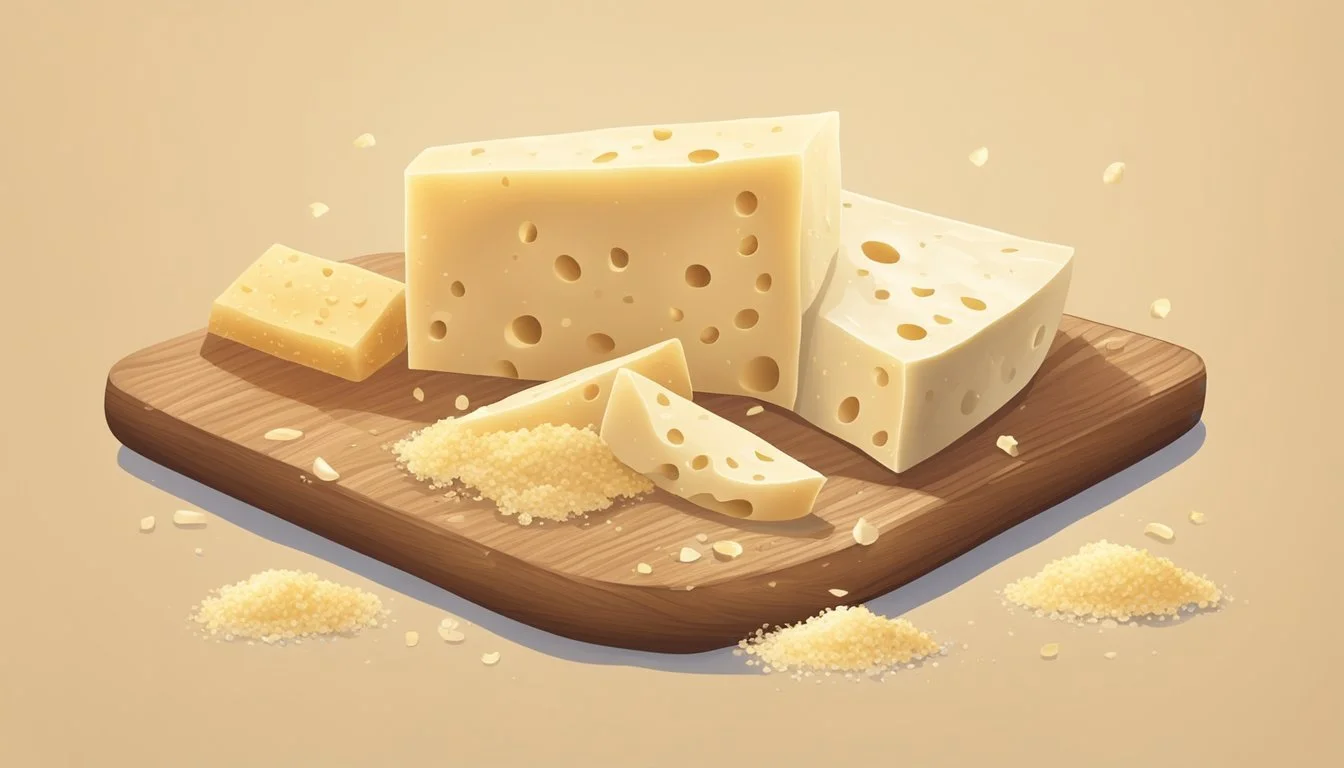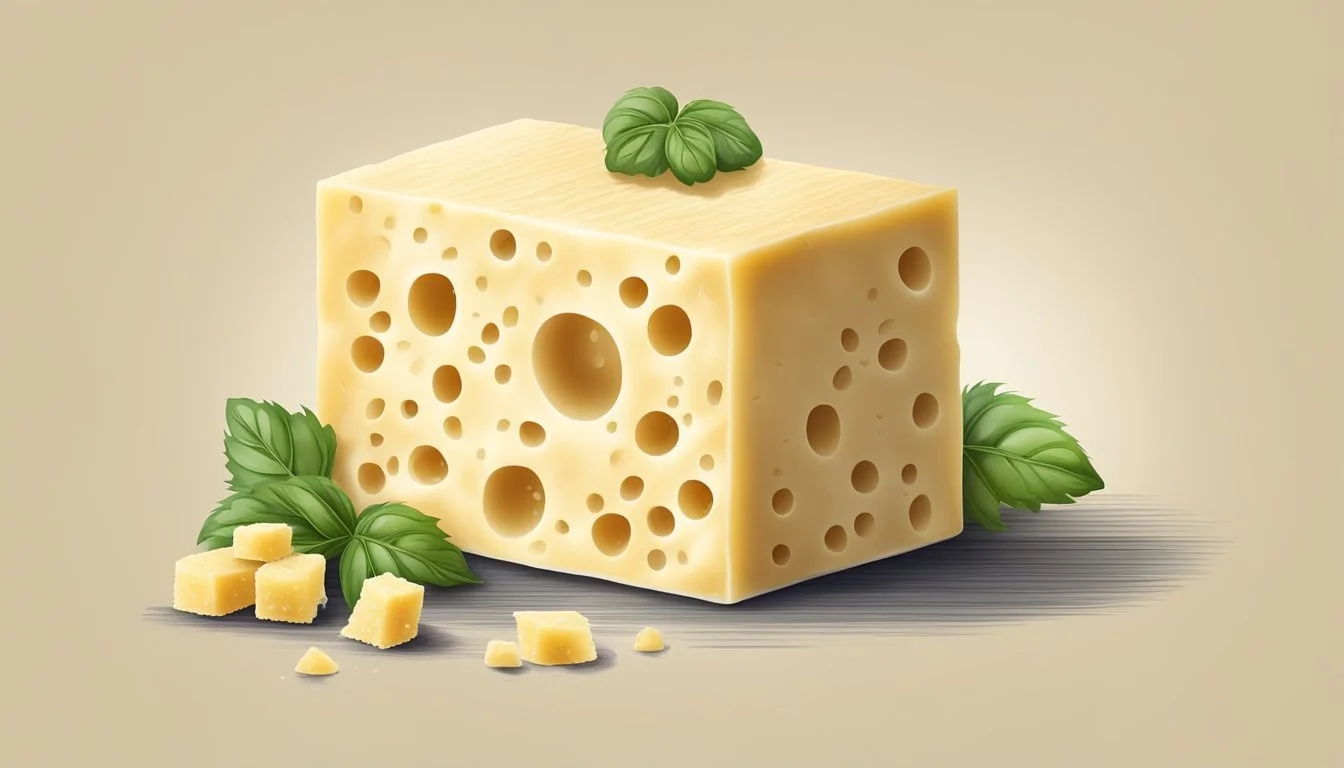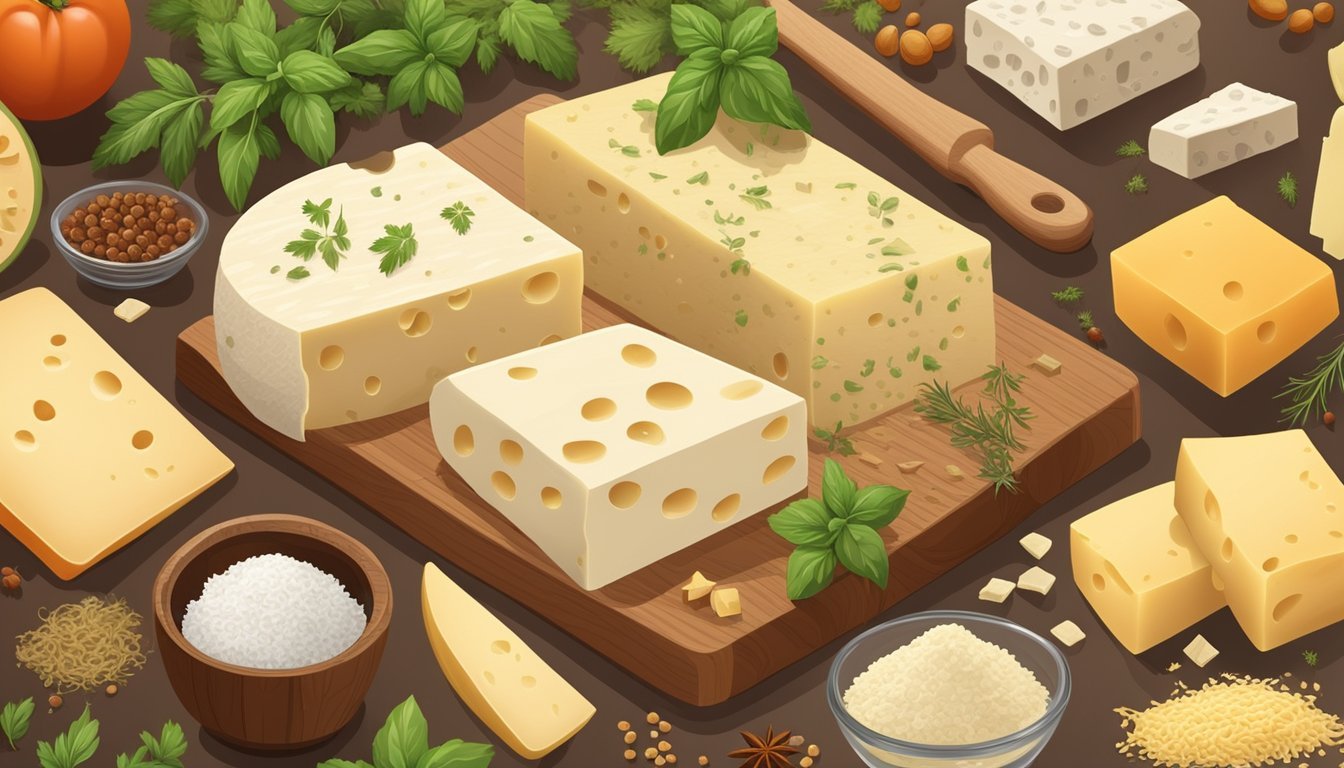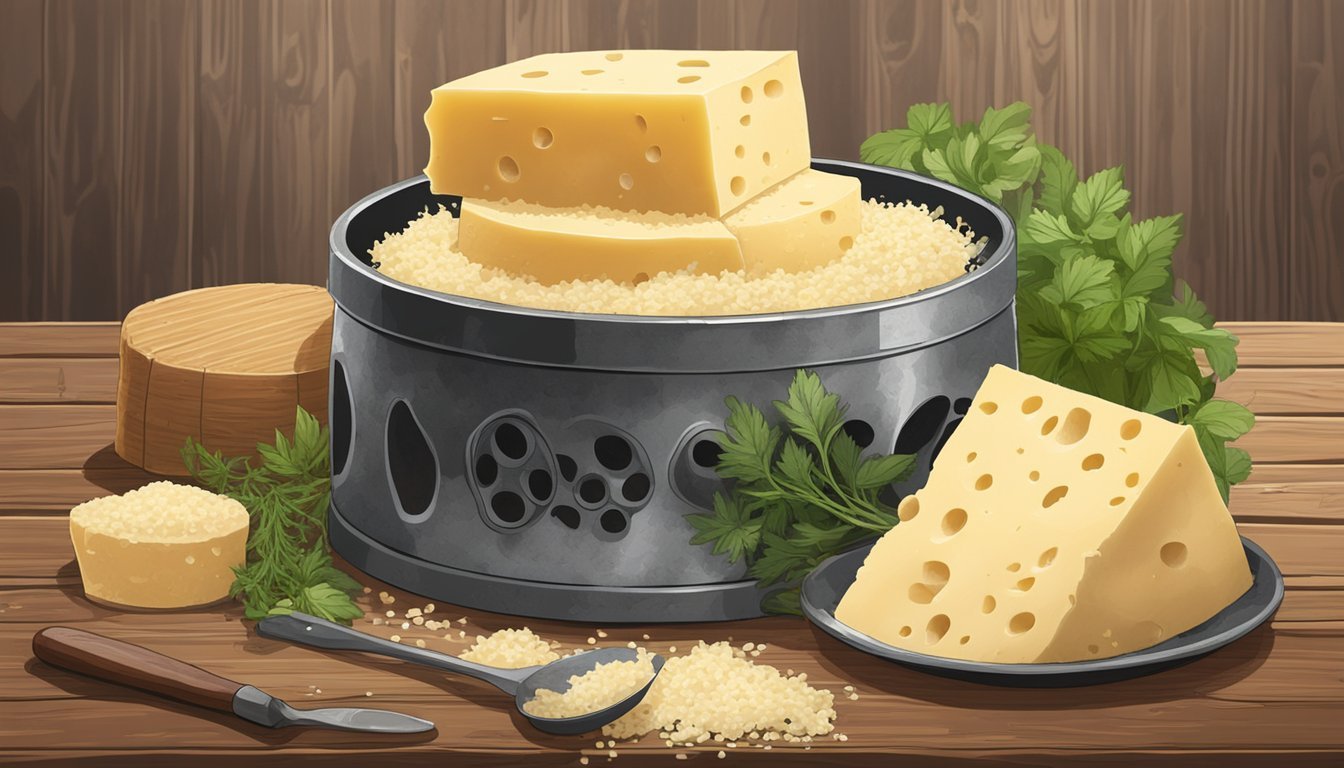Does Parmesan Cheese Go Bad?
Understanding Shelf Life and Storage Tips
Parmesan cheese, known for its hard texture and sharp, nutty flavor, is a staple in many kitchens and an integral component of numerous Italian dishes. Technically named Parmigiano-Reggiano, this Italian cheese (What wine goes well with cheese?) is the product of an age-old process that involves a careful aging period ranging from 12 to 36 months. The aging not only contributes to its distinct flavor profile but also to its relatively long shelf life compared to softer cheeses.
Despite its durability, Parmesan does indeed have a finite shelf life and can go bad. It's important to recognize that the longevity of Parmesan cheese can be affected by how it's stored. Proper storage conditions are key in preventing spoilage and maintaining its quality. When kept unopened in the refrigerator, Parmesan can remain at its best for 7 to 9 months, while its grated counterpart may have a shorter shelf life.
When assessing the quality of Parmesan, look for telltale indicators of spoilage such as an off smell, changes in taste, or the presence of mold which typically suggests that the cheese has deteriorated. As it's a hard cheese, slight surface mold can often be trimmed away, but extensive mold growth or any signs of spoilage should not be taken lightly. Ensuring the cheese is wrapped tightly and kept cool is imperative to extend its freshness and prevent waste.
Understanding Parmesan Cheese
Parmesan cheese, known in its homeland Italy as Parmigiano-Reggiano, is a hard, granular cheese that is both revered and widely used in various cuisines around the world. Its production is tightly regulated and can only be legitimate if it hails from specific regions: Parma, Reggio Emilia, Modena, and parts of Bologna.
The cheese's distinct rich flavor and slightly gritty texture come from a meticulous aging process, during which it is allowed to mature for a minimum of 12 months, though it can age for up to 36 months or longer. As it ages, it takes on a deeper, nuttier profile. The longer aging periods contribute not only to its flavor but also to the hardness of the cheese.
Characteristics of Parmesan:
Texture: Hard, crumbly
Color: Straw yellow
Rind: Natural, inedible
During production, the cheese forms a thick rind, a byproduct of the aging process, which is often used to impart flavor in soups and stocks. The rind signifies the cheese has undergone proper aging and is a hallmark of authenticity.
The term "Parmesan" is used as a generic label outside the European Union and may not always adhere to the stringent aging and production criteria defined by the Protected Designation of Origin (PDO) standards. However, original Parmigiano-Reggiano holds PDO status, ensuring that it is produced under the highest standards and with traditional methods in its place of origin. This certification guarantees consumers are experiencing the authentic Italian cheese as it is meant to be served.
Signs of Spoilage
Parmesan cheese, known for its durability, is not impervious to spoilage. Recognizing the signs of spoilage involves examining visual cues, assessing texture changes, and identifying alterations in odor.
Visual Indicators
When inspecting Parmesan cheese for spoilage, visual indicators play a crucial role. The development of mold growth is the most obvious sign, which may appear as white spots or more extensive mold spots. Another telltale sign is discoloration; any color changes to the cheese's typically pale-yellow hue should be noted.
Texture Changes
The texture of Parmesan cheese is typically hard and granular. Spoilage is often accompanied by a change in texture, which may result in the cheese becoming slimy or unusually soft. Such textural deviations are clear indicators that the cheese may no longer be suitable for consumption.
Odor Assessment
Parmesan has a distinct, nutty smell that should not be unpleasant. An unpleasant odor is a reliable sign of spoilage. Cheese that has taken on a sour or otherwise unpleasant odor should be discarded, as it indicates an unwelcome change in the product's chemical makeup.
Storage Guidelines
Proper storage is paramount for maintaining Parmesan cheese's quality and extending its shelf life. The following subsections provide specific recommendations for refrigeration, freezing, and packaging methods.
Refrigeration Technique
Parmesan cheese should be stored in the refrigerator at a consistent temperature ranging between 35°F and 45°F (1.7°C and 7.2°C) to prevent spoilage. Opened blocks of Parmesan can last approximately 4 to 6 weeks when stored correctly.
Sealed: Place the cheese in an airtight container or seal it tightly with plastic wrap.
Moisture Control: Wrapping it with cheese paper or parchment paper before sealing may help to regulate moisture.
Freezing Tips
Freezing grated Parmesan cheese is acceptable, while freezing a block of Parmesan is not recommended due to potential texture changes.
Short-term: For optimal use, store grated cheese in the freezer for up to three months.
Heavy-Duty Protection: Use an airtight container or double wrap with aluminum foil and plastic wrap for best results.
Packaging Methods
Correct packaging preserves the cheese's texture and flavor while preventing the growth of mold.
Blocks: Wrap cheese blocks first in wax paper, then in aluminum foil.
Grated Cheese: Store in airtight containers with minimal headspace or in resealable plastic bags with the air removed.
By adhering to these guidelines, one can ensure that Parmesan cheese remains fresh and delicious until its maximum shelf life.
Shelf Life
Parmesan cheese, known for its hard texture and low moisture content, boasts an impressive shelf life compared to softer cheese varieties. When unopened, a block of Parmesan can retain its best quality for around a year when stored properly in the fridge. Once opened, the cheese maintains its freshness for about 1-2 months if kept refrigerated and handled with care.
Grated Parmesan presents a slightly different scenario. The shelf life of grated Parmesan sold in airtight containers and kept unopened in the pantry can be quite long due to its low moisture and preservatives. Upon opening, however, it should be consumed within 1-2 months for best quality. If purchased from the refrigerated section, it's advisable to use the cheese within 3-5 days after opening to ensure maximum freshness.
Here’s a quick reference for the shelf life of Parmesan cheese:
Parmesan Type Unopened Opened Block Parmesan 1 year (refrigerated) 1-2 months (refrigerated) Grated Parmesan (Pantry) Use by best-by date 1-2 months (refrigerated) Grated Parmesan (Fridge) Use within 3-5 days (refrigerated) Use within 3-5 days (refrigerated)
Signs that Parmesan cheese has surpassed its shelf life include an off smell, an alteration in taste, the presence of mold, or any discoloration. To extend the shelf life and maintain freshness, Parmesan should be stored in one piece, wrapped securely in a moisture-proof material, such as wax paper or aluminum foil, and refrigerated.
Proper Use and Handling
When it comes to enjoying Parmesan cheese, its culinary versatility is matched by the need for proper handling to maintain quality and safety. Whether grated, shredded, or in block form, it brings a depth of flavor to various dishes. Attention to detail in its use and storage ensures that Parmesan remains delicious and safe to consume.
Cooking Applications
Parmesan cheese is a staple in Italian cuisine, often used to enhance the flavor of dishes. It is commonly grated over pasta, sprinkled on pizza for a crispy crust, or stirred into soups and sauces for a savory touch.
Pasta & Pizza: Generously top with grated or shredded Parmesan to add a salty, nutty flavor.
Soups & Sauces: A spoonful of grated cheese can add complexity to simple dishes.
Pairing Suggestions
Beyond its common use in hot dishes, Parmesan cheese makes an excellent pairing with various fruits for a refreshing and balanced snack. Serving suggestions include:
Fruits: Create a sophisticated appetizer by combining slivers of Parmesan with pears or apples.
Salads: Enhance flavors by shaving blocks of Parmesan over fresh salads.
Handling Precautions
Careful handling is crucial to preserve the quality and safety of Parmesan cheese. Whether dealing with a block of Parmesan cheese, grated Parmesan, or shredded Parmesan, the following precautions are recommended:
Blocks: Store in the fridge, wrapped in foil, to prevent moisture and mold.
Grated or Shredded: Use within 1-2 months of opening, adhere to the best-by date, and keep in an airtight container.
Freezing Parmesan Cheese
Freezing Parmesan cheese can effectively extend its longevity, safeguarding its flavor and utility in the kitchen for extended periods. The process is straightforward, yet requiring attention to detail to preserve the cheese's quality.
Steps for Freezing Ungrated Parmesan:
Wrap: Firstly, it's crucial to wrap the cheese block in parchment or wax paper. This step is important as it protects the cheese from absorbing other flavors.
Enclose: After wrapping, place the Parmesan block in an airtight plastic bag or a heavy-duty freezer bag. This bag helps maintain the appropriate moisture content.
Expel Air: Remove as much air as possible before sealing the bag to prevent freezer burn.
Label: Mark the bag with the date, ensuring you keep track of how long the Parmesan has been stored.
For grated Parmesan:
Spread the grated cheese on a baking sheet lined with parchment paper.
Freeze for about 30 minutes until solid.
Transfer the frozen grated cheese to a freezer bag, follow the same air removal and labeling procedures.
Considerations:
Texture Change: It's important to recognize that freezing can alter the texture of Parmesan, with the potential of it becoming crumblier once thawed.
Moisture Content: Due to its low moisture content, Parmesan tolerates freezing well, especially when proper preparation is observed.
When it comes to using frozen Parmesan, there is no need to thaw the cheese; it can be used directly from the freezer, particularly grated Parmesan, which makes it convenient for adding directly to hot dishes. By following these distinct steps, one ensures that Parmesan cheese retains its desired qualities and is preserved safely for future culinary use.
Food Safety Concerns
When considering the food safety of Parmesan cheese, the primary concern is the potential for spoilage and the growth of mold or bacteria, which can lead to foodborne illnesses. Parmesan cheese, due to its hard texture and low moisture content, is less susceptible to bacteria growth compared to softer cheeses. However, it is not immune.
Storage: Parmesan cheese should be refrigerated, ideally between 35-40 degrees Fahrenheit, to slow down the growth of harmful bacteria. If left at room temperature, the risk of bacteria proliferation increases, potentially causing spoilage.
Spoilage Indicators:
Visual: Presence of mold, often green or black spots, is a clear indication of spoilage.
Olfactory: A sour or ammonia-like odor that deviates from Parmesan's typical nutty and savory aroma is a warning sign.
Preventive Measures:
Store the cheese in the fridge wrapped tightly in plastic wrap or aluminum foil.
Use clean utensils when handling to prevent cross-contamination.
Cut away at least 1 inch around and below the moldy spot, ensuring that the knife does not touch the mold.
Note on Mold: Not all mold on cheese is hazardous, as some cheeses have edible mold. However, on Parmesan, visible mold is a sign of spoilage, and the affected parts should be removed immediately.
Always practice good hygiene when handling Parmesan cheese to minimize the chance of introducing bacteria that can lead to spoilage. If the cheese exhibits any signs of spoilage, discard it to prevent the risk of foodborne illness.
Maximizing Parmesan Cheese Quality
When it comes to maintaining the quality of Parmesan cheese, proper storage techniques are crucial. Its low moisture content contributes heavily to its durability and distinct nutty flavor, but to preserve its taste and texture, one must ensure optimal storage conditions.
Refrigerator Storage: Parmesan should be kept in the refrigerator, ideally between 40-45°F (4-7°C). To protect its quality, store Parmesan cheese in the crisper drawer if possible, as it tends to maintain a consistent temperature.
Wrapping Techniques:
For unopened Parmesan, keep it in its original packaging until ready to use.
Once opened, wrap Parmesan cheese tightly in plastic wrap or aluminum foil. This protects it against moisture loss and external flavors.
For an extra step, consider using a vacuum sealer for opened pieces of Parmesan to extend its shelf life.
Handling Grated Parmesan: Grated Parmesan has more surface area exposed, making it more susceptible to spoilage. It's recommended to:
Use grated Parmesan within 5-7 days after opening.
Store in an airtight container to minimize exposure to air.
Avoiding Moisture: Parmesan's quality is best preserved by preventing exposure to moisture. If any moisture is detected in the storage container, it should be removed promptly to prevent mold growth.
By following these storage recommendations, one can ensure the savory, nutty flavor and the firm texture of Parmesan cheese remain intact for as long as possible.
FAQs about Parmesan Cheese
Can Parmesan Cheese Go Bad?
Yes, Parmesan cheese can expire. Due to its low moisture content and hard texture, it has a longer shelf life than soft cheeses. The aging process enhances its granular texture, but signs of spoilage include an off smell, taste, or visible mold.
How Should Parmesan Cheese Be Stored?
Proper storage is crucial to extend its shelf life:
Whole Parmesan: Keep it wrapped in foil or parchment and store in the refrigerator at 40-45°F (4-7°C).
Grated Parmesan: Once opened, store it in an airtight container in the refrigerator.
What Is the Best Temperature for Refrigeration?
Parmesan should be refrigerated consistently at 40-45°F (4-7°C).
Does Parmesan Cheese Have a Best-By Date?
It does. The best-by date indicates peak quality. Parmesan can be safe to eat after this date, especially if stored correctly and shows no signs of spoilage.
What Are the Signs of Spoilage in Parmesan Cheese?
Spoilage is indicated by:
Odd or sour smell
Mold growth
Discoloration
How Long Can Parmesan Cheese Last?
State of Cheese Shelf Life Unopened, Refrigerated 7-9 months Opened, Refrigerated 1-2 months (to retain best quality) Grated, Unrefrigerated Less than a month for best quality Unopened & Frozen Up to 12 months (wrap properly before freezing)
Can Aged Parmesan Cheese Become Crumbly?
As Parmesan cheese ages, it becomes drier and more crumbly, which is a natural aspect of its character, not necessarily an indication of spoilage.
Alternatives and Substitutes
When Parmesan cheese is unavailable or someone is seeking variety, there are several substitutes that can be used, particularly for pasta dishes and other Italian cheese-inspired recipes. These alternatives maintain the same general profile of being hard, aged cheeses, and can often be used in a 1:1 ratio.
Pecorino Romano is a well-known alternative to Parmesan with a salty, tangy flavor and a hard, crumbly texture. Originally made from sheep's milk, it complements pasta, salads, and soups effectively.
Grana Padano, with its nutty and slightly milder profile than Parmesan, is another Italian cheese that works well grated over dishes or in sauces and risottos. Manchego, a Spanish cheese, offers a more intense, zesty, and slightly salty flavor and can also be a viable substitute for Parmesan.
For those looking for non-dairy options, nutritional yeast is often recommended. It provides a cheesy flavor and can be sprinkled on pasta dishes or used in pestos.
Substitute Taste Texture Common Uses Pecorino Romano Salty, tangy Hard, crumbly Pasta, salads, soups Grana Padano Nutty, milder Hard, granular Grating, sauces, risottos Manchego Zesty, slightly salty Paler, aromatic Pasta, topping Nutritional Yeast Cheesy Flaky Pasta, pesto, topping
While aged cheddar is flavorful and versatile, its sharper taste and creamier texture make it less ideal as a direct substitute for Parmesan in Italian dishes. Chefs should select their cheese alternative based on the desired final taste and texture of their dish.
The Aging Process of Parmesan Cheese
Parmesan cheese, also known as Parmigiano-Reggiano, is a hard, granular cheese with a rich history and a meticulous aging process. This cheese is produced using traditional methods that have been refined over centuries, with a strong adherence to rules that define its characteristics and quality.
Aging Duration:
Minimum: 12 months
Maximum: 36 months or more for greater intensity
The aging process is crucial in developing Parmesan's unique flavor and texture. As the cheese matures, its low moisture content allows it to do so without compromising its integrity. The longer the cheese is aged, the more complex and pronounced its flavors become. It transitions from a subtle, nutty taste to a sharp and robust profile with potential caramel undertones.
Texture Changes:
Younger: Softer, milder
Older: Grainier, crumblier
Parmigiano-Reggiano's low moisture content is key to its longevity and enables it to be stored for extended periods, thus favoring a prolonged aging process. This low moisture also plays a significant role in the cheese's resistance to spoilage.
Maintenance of Quality:
Storage: Refrigerated, wrapped in foil
Handling: Proper hygiene practices
As cheese aficionados will note, aging Parmesan cheese is an art that results in a product that's not only a culinary staple but also an embodiment of tradition. Each wheel of Parmesan is a testament to the art of cheese aging, where time is the most crucial ingredient.
Significance and Origin of Parmesan
Parmesan cheese, repudiated globally as a quintessential Italian cheese, originates from the areas surrounding Parma, Reggio Emilia, Modena, and part of Bologna. Known in Italy as Parmigiano-Reggiano, it's a hard, granular cheese that is a staple in Italian cooking and has international acclaim for its distinct flavor and versatility.
Traditionally, Parmigiano-Reggiano signifies more than just sustenance; it embodies a heritage of artisanal craftsmanship passed down through generations. It's deeply interwoven with the cultural fabric of the regions where it is produced, which are the only places where authentic Parmigiano-Reggiano can be made.
This cheese is celebrated for its Protected Designation of Origin (PDO) status, which mandates that it must be produced according to strict traditional methods within the designated areas to carry the name. The PDO recognition not only preserves the technique and integrity of Parmesan cheese but also its regional significance.
Here's a concise overview of Parmesan's profound roots:
Origin: Northern Italy
Key Regions: Parma, Reggio Emilia, Modena, and parts of Bologna
Cheese Type: Hard, granular
Italian Name: Parmigiano-Reggiano
Tradition: Centuries-old artisanal production
PDO Status: Yes, with strict geographical and production standards
Produced using raw cow's milk, the cheese's complex production includes a meticulous aging process that enhances its texture and depth of flavor. This aging can last from a minimum of 12 months to over 36 months, contributing to the final product's robust taste profile which Italians hold in high esteem.







